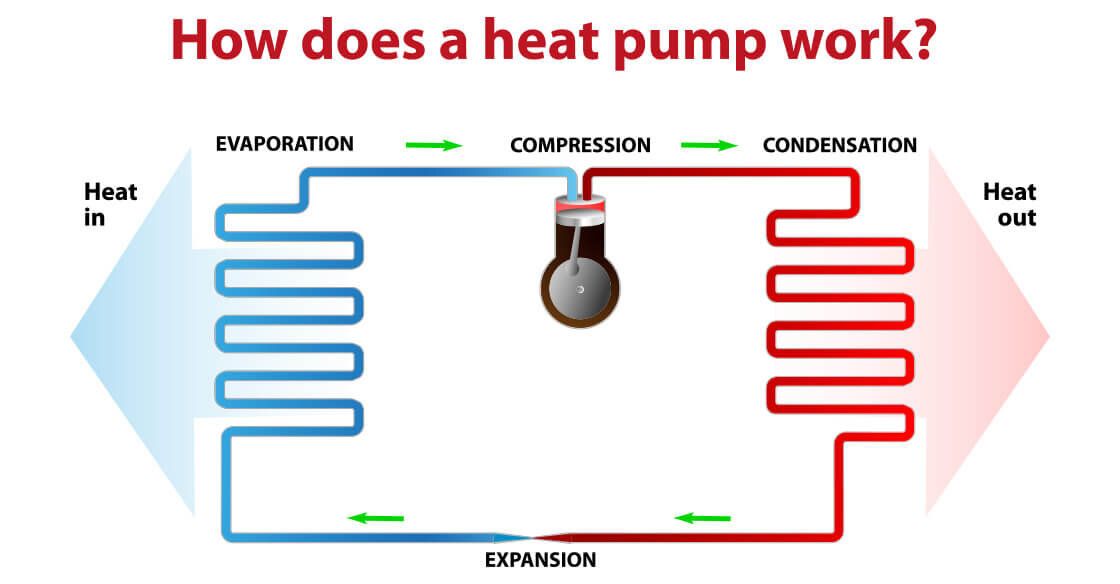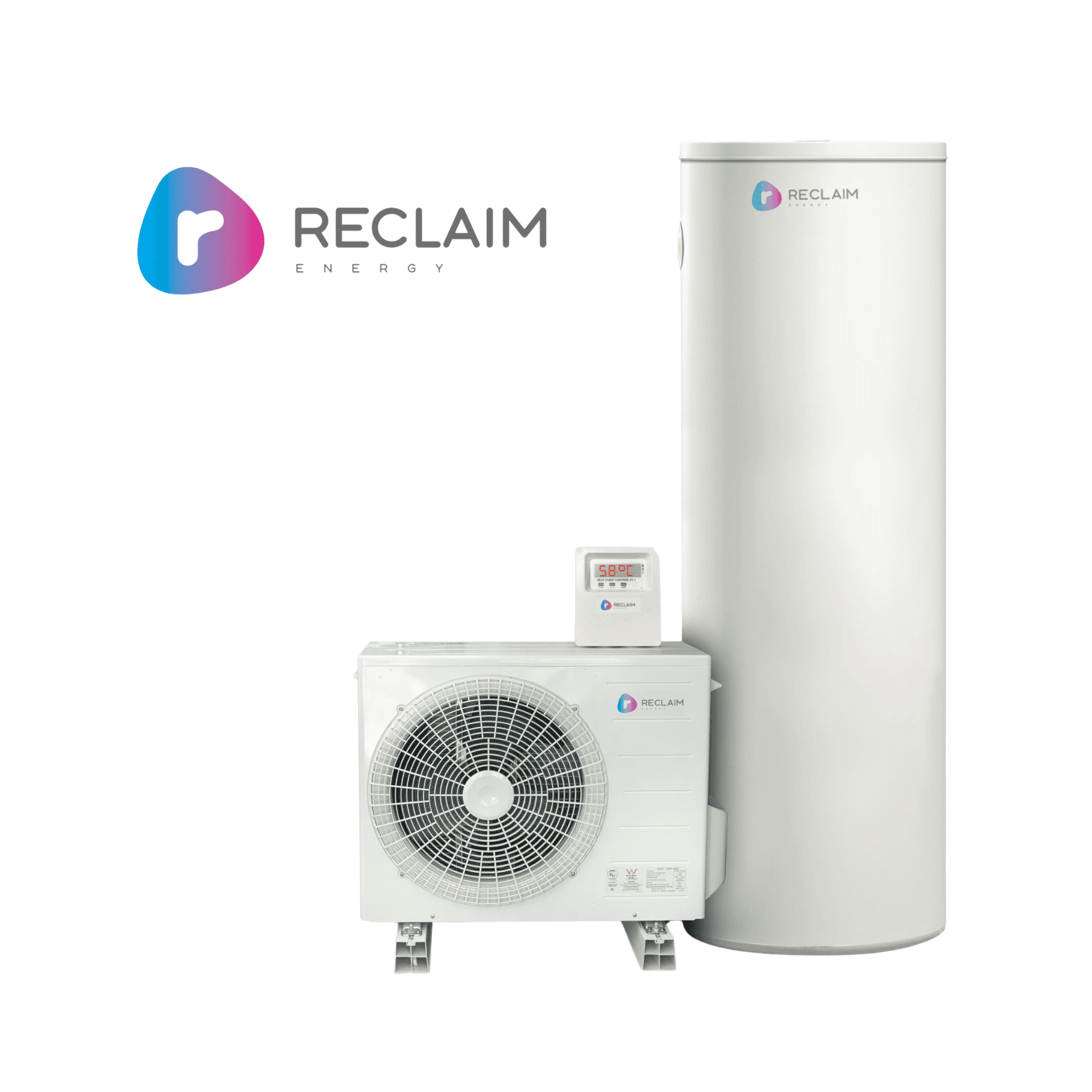Frequent questions and answers on Heat Pumps
Heat pumps can be an extremely energy-efficient form of space heating and cooling – provided they are sized, installed, and used properly.
Heat pumps can be an extremely energy-efficient form of space heating and cooling – provided they are sized, installed, and used properly.
1. What is a Heat pump?
A heat pump works on the same principle as a refrigerator, but instead of pumping heat out of the fridge to keep it cool, they pump heat into the water. Electricity is used to pump a refrigerant through the system. The refrigerant transfers the heat absorbed through the air to the water in the tank.
Diagram 1. Workings of a heat pump

Heat pumps work through the use of a refrigerant that evaporates at low temperatures.
There are several steps in the process:
- A liquid refrigerant passes through an evaporator where it picks up heat from the air and becomes a gas.
- The gas refrigerant is compressed in an electric compressor. Compressing the gas causes its temperature to increase so that it becomes hotter than the water in the tank.
- The hot gas flows into a condenser, where it passes its heat to the water and turns back into a liquid.
- The liquid refrigerant then flows into an expansion valve where its pressure is reduced, allowing it to cool and enter the evaporator to repeat the cycle.
A heat pump uses electricity to drive the compressor and the fan instead, unlike a traditional electric resistance water heater that uses electricity to directly heat the water. The heat pump is able to transfer a much greater amount of heat energy from the surrounding air to the water, which makes it highly efficient. The amount of heat that is able to be transferred from the air to water depends on the ambient temperature.
While the outside temperature is higher than the cold refrigerant, the heat pump will absorb heat and move it to the water. The warmer the outside air, the easier it is for the heat pump to provide hot water. As the outside temperature decreases, less heat can be transferred, which is why heat pumps don’t work as well in places where temperatures are low.
In order for the evaporator to allow heat to be absorbed continuously, there needs to be a constant supply of fresh air. A fan is used to assist airflow and remove the cooled air.
Heat pumps are available in two configurations; integrated/compact systems, and split systems. - Integrated/compact systems: the compressor and the storage tank are a single unit.
- Split systems: the tank and the compressor are separate, like a split system air conditioner.
2. Advantages and disadvantages of heat pumps
Advantages of an air-to-air heat pump include:
- it is very efficient at converting energy to heat (optimum efficiency is when the difference between source and supply temperatures is very small)
- it provides a medium to fast source of heat
- it has the ability to provide heating and cooling
- Many have timer controls programmable for 7 days and some connect to home WiFi to allow remote control via smartphone.
Drawbacks of air-to-air heat pumps are:
- regular maintenance is required (cleaning the filter on the indoor unit) and service check every 2–3 years
- loss of efficiency as temperature decreases below 6–7ºC (but some models can still provide heating in temperatures down to -15ºC)
- higher initial purchase and installation cost than portable heaters
- air distribution is by a fan, which can cause draughts and some noise
- space is needed to install the exterior unit
- penetrations have to be made through the weather skin of the building
- no heating during a power cut.
Although heat pumps are an efficient form of heating, installing a heat pump is not likely to reduce heating costs. In a BRANZ study of 160 households with heat pumps, more people said their energy costs had increased since acquiring a heat pump than those who said their energy costs had fallen. Only 15% described running costs as excellent. Occupants keep their homes warmer than previously.
Heat pumps do not replace the need for good insulation. In that same BRANZ study (covered in BRANZ Study Report 329), half the households that achieved less than 18°C average winter evening temperatures had no or poor insulation.
3. The energy efficiency of heat pumps for space heating.
As heat pumps only move heat and do not actually generate it, they have a very high ratio of heat output to energy input. This heating energy efficiency is expressed as a coefficient of performance (COP), while cooling energy efficiency is expressed as an energy efficiency ratio (EER).
Typical domestic heat pumps have a COP of 2–4.5, which means the heat pump produces about 2–4.5 times as much heat as the electricity it uses (under optimum conditions). Some heat pumps have COP’s as high as 5.7. The efficiency of an air-to-air heat pump decreases as the temperature difference between source and supply increases – as outside temperatures drop, the heat pump’s energy efficiency reduces.
Heat pumps are currently the only form of heating, aside from solar, where the COP is (usually) greater than 1, which makes them the most efficient form of purchased space heating commonly available.
The cooling energy efficiency ratio (EER) is typically about 2.5–4.0, which means the heat pump produces about 2.5–4 times as much cooling power as the electricity it uses. Some heat pumps have EER’s as high as 5.8.
When selecting a heat pump, consider its primary use. If it will mostly be used for heating, select for a high COP; if mostly used for cooling, select for a high EER.
Under the Energy Efficiency (Energy Using Products) Regulations 2002, heat pumps for sale in New Zealand must meet the Minimum Energy Performance Standard (MEPS) given in AS/NZS 3823.2:2013 Performance of electrical appliances - Air conditioners and heat pumps – Part 2: Energy labelling and minimum energy performance standards (MEPS) requirements.
An Energy Rating Label must be displayed on all new heat pumps for sale. The label shows a star rating – the more stars (out of a possible 10), the more energy efficient the heat pump is. More efficient models have lower running costs.
New Zoned Energy Rating Labels are being introduced, replacing the old energy rating label. As before, the new labels assign up to 10 stars to a unit, but the key difference in the new label is that it now includes how a model will perform at a low outside temperature of 2°C in addition to the existing 7°C assessment. This will be of benefit to people in colder parts of New Zealand.
How do air source heat pumps work and why are they more efficient then gas or electrical heating?
Even cold ambient air contains useful energy.....
In an air source heat pump refrigerant is evaporated in the external air-side heat exchanger, this vapour is then compressed by the compressor and pushed into an internal (air or water) condenser where the heat is removed condensing the vapour back into a liquid. It is this removed heat which is used to heat the water or space.
Typically for every 1kW of electrical energy consumed by the compressor, it moves 3kW of heat from the ambient air to the inside space or water circuit, giving a Coefficient of performance of 4:1 becuase the 1kW of compressor energy also ends up as useful heat.
Defrosting.....
The air-side heat exchanger becomes cold in operation and as ambient temperatures drop ice forms on the fins of the evaporator coil. Sensors in of evaporator coils monitor the build-up of ice and when the unit needs to defrost the refrigerant cycle is reversed for a short time at “part load” to put heat into the coil and remove the ice. On units with multiple circuits only one circuit will defrost at any one moment in time ensuring a constant positive heat output from the unit.

Free Registration
To express your interest, simply fill out the form. We'll be in touch in 2 business days. Installation priority will be based on the registration list, so act fast!
